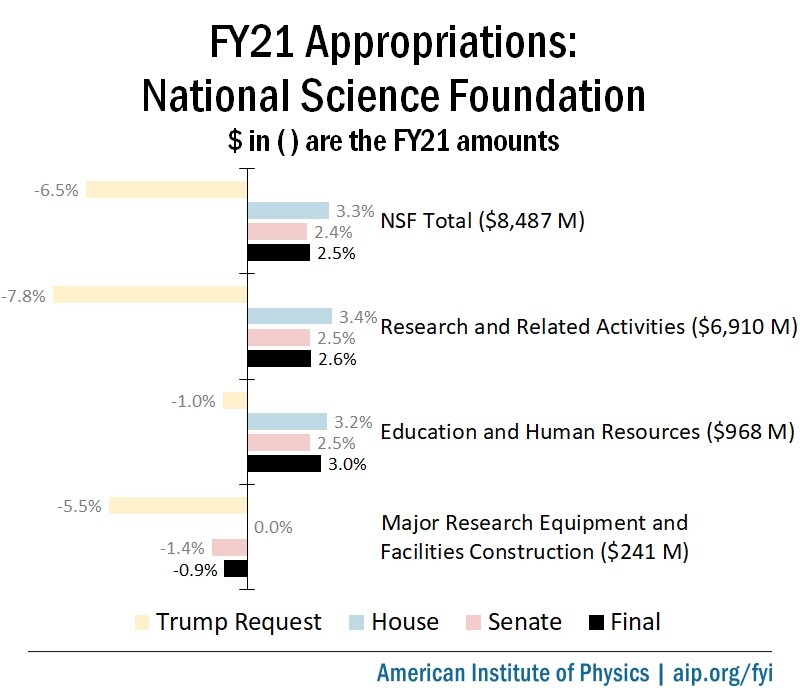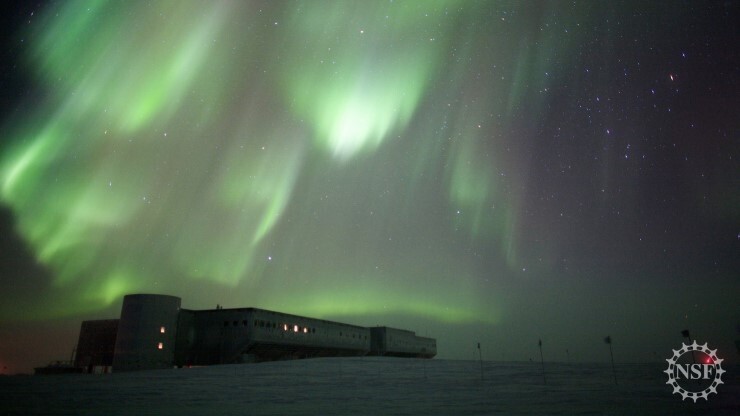
Final FY21 Appropriations: National Science Foundation
With Congress’ appropriations package
An explanatory statement

Selected research priorities
NSF’s Research and Related Activities account, which funds six disciplinary research directorates, is increasing 3% to $6.91 billion. Per custom, Congress does not specify how NSF should distribute funding across these directorates, but it does provide instruction on certain points.
Disciplinary balance. Reiterating language from previous years, Congress directs NSF to provide at least level support for “core research” and use its set of cross-disciplinary Big Ideas
The House report also directs NSF to provide at least level funding for the Social, Behavioral, and Economic Sciences Directorate, explaining, “SBE funds over half of our nation’s university-based social and behavioral science research but remains one of the smallest NSF directorates. The committee believes this research provides an evidence-based understanding of the human condition, resulting in more-informed policymaking and better-informed spending on a full range of national issues.”
Quantum research. Congress directs NSF to spend up to $226 million on quantum information science, matching the requested
Artificial intelligence. Congress directs NSF to spend up to $868 million on AI-related grants and initiatives, matching the requested
Minority-Serving Institutions. The House report directs NSF to detail how research it funds is “contributing to the success of Historically Black Colleges and Universities.” It also encourages NSF to support research on “how HBCUs with diverse academic cultures successfully graduate African American students at a higher rate than other institutions; produce a higher rate of African American STEM students receiving PhDs; and instill in students a greater sense of well-being.” The final explanatory statement expands this direction to include Hispanic Serving Institutions, Alaska Native Serving Institutions, Native-Hawaiian Serving Institutions, and Tribal Colleges and Universities.
EPSCoR. NSF is directed to allocate at least $200 million to its Established Program to Support Competitive Research, a 5% increase, supporting projects in states that receive a low proportion of federal research funds.
Laser research. Congress encourages NSF to implement recommendations from a 2017 National Academies report
Research infrastructure

An image from NSF’s collection of Zoom backgrounds showing an aurora australis over the agency’s research base at the South Pole. NSF also operates two coastal bases in Antarctica: McMurdo and Palmer Station.
(Image credit – Patrick Cullis / U.S. Antarctic Program)
Major facilities. Funding for NSF’s Major Research Equipment and Facility Construction (MREFC) account will stay essentially level at $241 million, with Congress providing the requested amounts for construction of the Vera C. Rubin Observatory and the in-progress upgrades to the Large Hadron Collider at CERN and the McMurdo base in Antarctica.
Mid-scale infrastructure. Within the MREFC account, Congress provides NSF’s mid-scale research infrastructure-2 program
Arecibo Observatory. Concerning the recent collapse
Infrastructure planning. In lieu of House language that expressed concern about NSF’s planning for the next generation of large facilities, “including ground-based telescopes,” Congress encourages NSF to “engage in robust planning for and investments in the next generation of world class facilities, including any projects recommended by the upcoming Astrophysics decadal survey.” The explanatory statement also overrides House language that encourages NSF to develop a “prioritized list of large-scale facilities requested by NSF-supported science disciplines.” It instead notes that the NSF director is required by law
Education and workforce programs
NSF funds research capacity-building efforts at minority-serving institutions, STEM education pedagogy research, and various fellowship programs through its Education and Human Resources account, which is increasing 3% to $968 million. The majority of the increase is directed toward programs that support groups underrepresented in STEM fields.
Minority-Serving Institutions. Congress allocates $47 million for the Hispanic-Serving Institutions program, a $2 million increase. The House report expresses particular concern about the “severe underrepresentation of Hispanic Ph.D. graduates in the STEM fields” and directs NSF to develop a plan to address the matter. It also notes that NSF does not have a dedicated program for Asian American and Native American Pacific Islander-Serving Institutions and “urges” the agency to increase grant funding opportunities for these groups.
Congress further specifies that NSF provide no less than a $2 million increase each for its HBCU Undergraduate program, Tribal Colleges and Universities program, and the Louis Stokes Alliances for Minority Participation.
Scholarships and fellowships. Congress specifically rejects proposed cuts to the Robert Noyce Teacher Scholarships program, the Improving Undergraduate STEM Education program, and the Graduate Research Fellowship Program, instead directing they be funded at the current level.
NSF workforce diversity. Congress directs NSF to produce a report that assesses “the current racial and cultural makeup of the foundation; planned efforts to recruit, retain, and advance applicants and employees critical to promoting greater racial and cultural diversity, and the outcomes of these efforts.”


